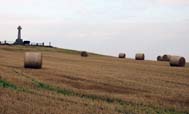… Calendars, Sundials, and Stone Chambers of Ancient Ireland
Synopsis (from the book cover):
Older than the pyramids and predating Stonehenge by at least a thousand years, the stone complexes of ancient Ireland have been extensively excavated and studied, ye they have refused to give up their mystery. Archaeologists have speculated that the chambers were tombs. Art historians have tried to interpret the enigmatic designs painstakingly carved into the faces of the stones. But the real function of these ancient structures can be understood only when the art and the architecture are seen to be parts of a unified whole.
Through a combination of careful observation, analysis of the astronomical alignment of the sites, and insightful interpretation of the megalithic symbols and carvings, Brennan argues that the mounds and art are interconnected, sophisticated calendar devices. At critical times of the year, the rising or setting sun projects beams of light into the inner chambers of the mounds, illuminating specific images carved on the stones. Those images – seemingly abstract wheels, spirals, and very wavy lines – suggest provocative new insights into their makers’ understanding of celestial cycles and the importance of those cycles in human affairs.
Review:
In the book the author explores the rock carvings and how they are aligned in the landscape and to their celestial orientation. His research and observations reveal that the ancient builders understood the yearly celestial cycles and carved them as markers on the stones. The book also reveals that the chambers themselves were aligned to specific solar and lunar events.
The book is a fascinating read complete with numerous diagrams and photographs to illustrate the research.









Fascinating. I can see enough ‘work’ there to keep an Historian/archeologist busy for an entire taxpayer-funded career, such that in 30 years we might have some idea about what they were for, at a cost of a mere couple of million pounds. Still, it keeps them off street corners and forces them into excercise, walking into and around remote places where they will find little mischief to get up to. I am always struck by these academic types descriptions of the metal prowess of the folk in those days. They were ’sophisticated’ it seems. Some of their building techniques were ’so advanced’ that we cannot figure out how they did it and could not do it today. Nice, though, to hear of them doing it in Ireland rather than the Gobi Desert where the folk are getting just a little terse !
It would be a truly bad idea to fund a mainstream archaeologist/historian to explore such sights. They are set in their ways and ideas and have a reputation to keep which does not allow for alternative thinking. In the case of the stone structures in this book the mainstream archaeologists were causing a problem, blocking up the original site lines so that they cannot be seen or explored…
The author of the book and his colleagues were observing and measuring how solstice events lined up perfectly with the stone structures in Ireland. Also how the stone carvings are measures in a yearly cycle.
Other authors have been able to show similar observations at Stonehenge and how it connects with its wider landscape.
All fascinating reading when backed up with measurements, photographs and diagrams
A more recent construction was built to display the sun through a slit on remembrance day.
http://www.thenma.org.uk/whats-here/armed-forces-memorial/
At 11 am on 11 November each year the sun shines through two slits in the outer and inner walls of the memorial, casting a shaft of light across a wreath in the centre.
I imagine you are reading this at the moment, Cherie?
I read this one last year justs after the book I reviewed about Stonehenge. I have a bit of a backlog in books that I intended to review.
I have one other book on the subject that I intend to review next.